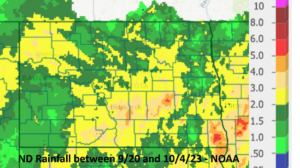
High Five. Hunters will likely find more opportunities to celebrate putting pheasant or two in their game vests this weekend as the season opens in North Dakota to higher tallies of young birds and total pheasants on the landscape. Simonson Photo.
By Nick Simonson
The North Dakota pheasant hunting season opens this Saturday, and for the first time in several years, populations have exhibited a significant jump over the previous season’s numbers. This, along with good cover conditions and likely favorable weather for the season’s start will help hunters find the roosters they are after. However, dwindling marginal lands, limited habitat on the landscape and a harvest process delayed by recent significant rainfall across the state may provide challenges to hunters as well. This preview of what’s to come for this opener and the pheasant season at large takes the ups and the downs of the factors that play into each fall and lays them out like each rise and draw that form the prairie landscape hunters will explore.
The Good
This summer’s roadside brood surveys conducted by the North Dakota Game & Fish Department (NDG&F) tallied statewide pheasant increases over 2022 results in broods, average size of broods, and total pheasants seen per 100 miles driven on the historic routes the agency uses each July 20 through Aug. 31 to track upland populations. In fact, the numbers for each major pheasant survey category were at their highest in recent memory, with broods (7.5/100 mi) the highest they’ve been since 2016 (12/100 mi). Brood sizes were also up to a recent high of 6.26 chicks per brood, the most in at least the past decade. Finally, the total average of all pheasants counted on each route statewide (65.4/100 mi) reached its highest point since 2016 (93.9/100 mi).

Ample spring moisture from the snowy winter along with well-timed early rains helped cover grow quickly for nesting pheasant hens across North Dakota’s pheasant range, but there was an added bonus of a bumper bug crop as well, which may have been the secret ingredient in this summer’s pheasant rebound, according to RJ Gross, NDG&F Upland Game Biologist.
“The habitat this spring really responded and grew up really nice and tall and lush and we didn’t have bad weather during the hatch and brood rearing,” he stated of the base requirements of a good nesting season, “but I think we had almost a plague of grasshoppers in some parts of the state, and that’s perfect food for those broods,” Gross adds, suggesting the source of insect protein helped those young birds develop in a timely fashion after hatching.
The Bad
While things are good where the grass has been growing all summer, Gross points out a diminishing amount of habitat in the form of conservation reserve program acres and other similar set-aside programs at both the federal and state level. Where these acres once exceeded three million in North Dakota, the amount has dwindled down to about a third of that at present. Continuing the pheasant rebound will likely come down to carrying capacity on the landscape and the availability for more quality habitat to support additional pheasant populations along with other wildlife such as mule and whitetailed deer which saw population decreases following the winter of 2022-23.

Recent rains have also slowed the harvest season down and the processing of bean fields and corn may be delayed slightly as a result. Additionally, areas that received significant rains in the past two weeks will likely sport muddy field access roads and swampier lowlands, making some travel tricky. Currently, according to the United States Department of Agriculture, North Dakota soybean fields harvested as of Oct. 1 stood at 23 percent which is equal to last year, and behind the 29 percent long-term average for the start of the month. Corn harvested as of the same date stood at eight percent, slightly ahead of three percent at that time last year, and the long term average of six percent. It’s the latter fields that give pheasants the advantage in the early goings, according to Gross.
“They figure it out pretty quick that they’re safe in a corn field. They don’t necessarily use bean fields all that often but corn they’ll really key in on. They do come out of there at least a few times a day if you can get lucky enough to catch them out of there. As soon as that gets off, then they’ll switch to that deeper cover like cattails and those draws,” Gross advises.
The Opener
Forecasts across the state of North Dakota look ideal for the first two days of the season, which begins on Sat. Oct. 7 and runs through Sun. Jan. 7, 2024. With light winds for both days of the weekend and lows in the 30s, and highs in the 50s and 60s, dogs won’t be challenged by hot conditions, and hunters will likely find cool environs facilitating the possibility of hunting all day, if need be, to collect their birds. The daily limit for pheasants in North Dakota is three roosters and the possession limit is 12. Hunting hours run from 30 minutes before sunrise until sunset each day of the season. More information on pheasant hunting in the state can be found at: https://gf.nd.gov/hunting/pheasant
